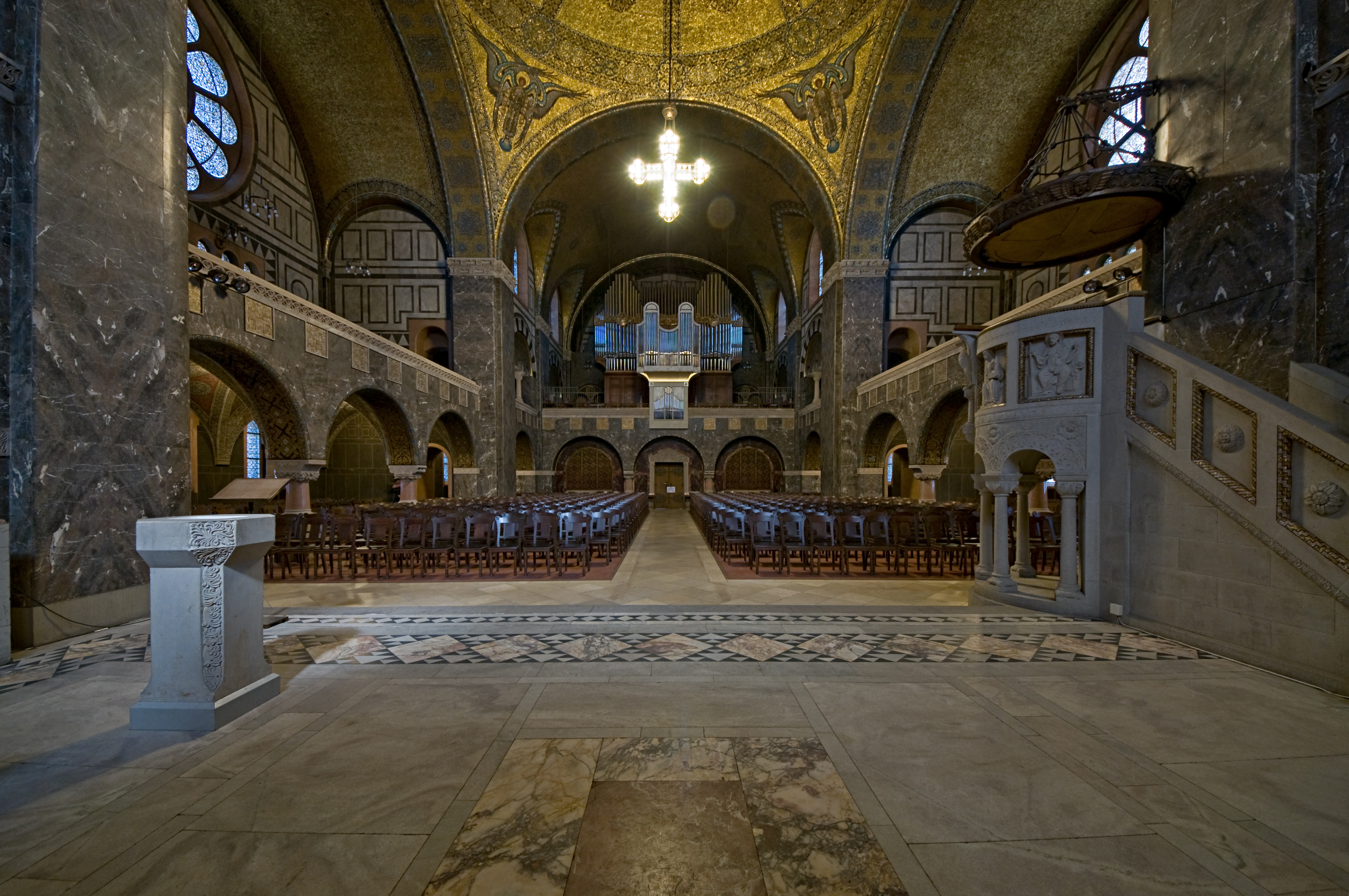|
Church Of The Redeemer, Bad Homburg
The Church of the Redeemer (German: Erlöserkirche) of Bad Homburg belongs to the Protestant Church in Germany. Finished in 1908, the building is outwardly of a heavy, Romanesque Revival appearance, while its interior is in a neo-Byzantine style, with rich marble wall decorations and gold mosaics covering the domed ceiling, leading to the church sometimes being called 'Bad Homburg's Hagia Sophia'.Churches - Erlöserkirche (from the official website. Accessed 2008-02-23.) History The church was built to serve |
Bad Homburg
Bad Homburg vor der Höhe () is the district town of the Hochtaunuskreis, Hesse, on the southern slope of the Taunus mountains. Bad Homburg is part of the Frankfurt Rhein-Main Regional Authority, Frankfurt Rhein-Main urban area. The town's official name is ''Bad Homburg v.d.Höhe'', which distinguishes it from other places named Homburg (other), Homburg. The town has become best known for its mineral springs and spa (hence the prefix ''Bad'', meaning "bath"), and for its casino. Bad Homburg was one of the wealthiest towns in Germany (while the Hochtaunuskreis itself and the Starnberg (district), Landkreis Starnberg in Bavaria regularly vie for the title of the wealthiest district in Germany). the town used the marketing slogan ''Champagnerluft und Tradition'' (Champagne air and tradition). History Medieval origins Local tradition holds that Bad Homburg's documented history began with the mention of the ''Villa Tidenheim'' in the Lorsch codex, associated with the year ... [...More Info...] [...Related Items...] OR: [Wikipedia] [Google] [Baidu] |
Philipp Holzmann
Philipp Holzmann AG was a German construction company based in Frankfurt am Main. History Early years The company was founded in 1849 by Johann Philipp Holzmann (1805-1870) at Sprendlingen in present-day Dreieich near Frankfurt am Main as Philipp Holzmann & Cie. Initially, the former sawmill company was concentrating on the supply of ties for railway construction, but then began to expand into building construction and civil engineering. In 1856, the headquarters moved to Frankfurt where in the late 19th century the company experienced rapid growth. The first large building contract to be finished was the opera house completed in 1880,Groß, p. 50 followed by the central station in Frankfurt am Main completed in 1888 and the Amsterdam Centraal railway station in 1889. Holzmann also built the original Reichstag building completed in 1894, the Hamburg city hall completed in 1897 and several railway projects in East Africa and Asia, especially the Bagdadbahn built from 1903 which ... [...More Info...] [...Related Items...] OR: [Wikipedia] [Google] [Baidu] |
Christ Pantocrator
In Christian iconography, Christ Pantocrator ( grc-gre, Χριστὸς Παντοκράτωρ) is a specific depiction of Christ. ''Pantocrator'' or ''Pantokrator'', literally ''ruler of all'', but usually translated as "Almighty" or "all-powerful", is derived from one of many names of God in Judaism. The Pantokrator, largely an Eastern Orthodox or Eastern Catholic theological conception, is less common under that name in Western Roman Catholicism and largely unknown to most Protestants. In the West, the equivalent image in art is known as Christ in Majesty, which developed a rather different iconography. ''Christ Pantocrator'' has come to suggest Christ as a mild but stern, all-powerful judge of humanity. When the Hebrew Bible was translated into Greek as the Septuagint, ''Pantokrator'' was used both for ''YHWH Sabaoth'' " Lord of Hosts" and for '' El Shaddai'' " God Almighty". In the New Testament, ''Pantokrator'' is used once by Paul () and nine times in the Book of Re ... [...More Info...] [...Related Items...] OR: [Wikipedia] [Google] [Baidu] |
Redeemer (Christianity)
In Christian theology, Jesus in Christianity, Jesus is sometimes referred to by the title Redeemer. This refers to the Christian soteriology, salvation he accomplished, and is based on the metaphor of Redemption (theology)#In Christianity, redemption, or "buying back". In the New Testament, ''redemption'' is used to refer both to deliverance from sin and to freedom from captivity. Although the gospels do not use the title "Redeemer", redemption is used in several of Pauline epistles, Paul's letters. Leon Morris says that "Paul uses the concept of redemption primarily to speak of the saving significance of the death of Christ." Universality The New Testament speaks of Christ as the one Saviour for all people.On Christ's role as universal Saviour, cf. Gerald O'Collins, ''Salvation for All: God's Other Peoples'', OUP (2008). The First Epistle of John says that Jesus is "the propitiation for our sins and not for ours only but also for the sins of the world" (wikisource:Bible (Ameri ... [...More Info...] [...Related Items...] OR: [Wikipedia] [Google] [Baidu] |
Art Nouveau
Art Nouveau (; ) is an international style of art, architecture, and applied art, especially the decorative arts. The style is known by different names in different languages: in German, in Italian, in Catalan, and also known as the Modern Style (British Art Nouveau style), Modern Style in English. It was popular between 1890 and 1910 during the Belle Époque period, and was a reaction against the academic art, eclecticism and historicism of 19th century architecture and decoration. It was often inspired by natural forms such as the sinuous curves of plants and flowers. Other characteristics of Art Nouveau were a sense of dynamism and movement, often given by asymmetry or whiplash lines, and the use of modern materials, particularly iron, glass, ceramics and later concrete, to create unusual forms and larger open spaces.Sembach, Klaus-Jürgen, ''L'Art Nouveau'' (2013), pp. 8–30 One major objective of Art Nouveau was to break down the traditional distinction between fine ... [...More Info...] [...Related Items...] OR: [Wikipedia] [Google] [Baidu] |
Byzantine Art
Byzantine art comprises the body of Christian Greek artistic products of the Eastern Roman Empire, as well as the nations and states that inherited culturally from the empire. Though the empire itself emerged from the decline of Rome and lasted until the Fall of Constantinople in 1453, the start date of the Byzantine period is rather clearer in art history than in political history, if still imprecise. Many Eastern Orthodox states in Eastern Europe, as well as to some degree the Islamic states of the eastern Mediterranean, preserved many aspects of the empire's culture and art for centuries afterward. A number of contemporary states with the Byzantine Empire were culturally influenced by it without actually being part of it (the "Byzantine commonwealth"). These included the Rus, as well as some non-Orthodox states like the Republic of Venice, which separated from the Byzantine Empire in the 10th century, and the Kingdom of Sicily, which had close ties to the Byzantine Empire a ... [...More Info...] [...Related Items...] OR: [Wikipedia] [Google] [Baidu] |
Altar
An altar is a table or platform for the presentation of religious offerings, for sacrifices, or for other ritualistic purposes. Altars are found at shrines, temples, churches, and other places of worship. They are used particularly in paganism, Christianity, Buddhism, Hinduism, Judaism, modern paganism, and in certain Islamic communities around Caucasia and Asia Minor. Many historical-medieval faiths also made use of them, including the Roman, Greek, and Norse religions. Etymology The modern English word '' altar'' was derived from Middle English '' altar'', from Old English '' alter'', taken from Latin '' altare'' ("altar"), probably related to '' adolere'' ("burn"); thus "burning place", influenced by '' altus'' ("high"). It displaced the native Old English word '' wēofod''. Altars in antiquity File:Tel Be'er Sheva Altar 2007041.JPG, Horned altar at Tel Be'er Sheva, Israel. File:3217 - Athens - Sto… of Attalus Museum - Kylix - Photo by Giovanni Dall'Orto, ... [...More Info...] [...Related Items...] OR: [Wikipedia] [Google] [Baidu] |
Tympanum (architecture)
A tympanum (plural, tympana; from Greek and Latin words meaning "drum") is the semi-circular or triangular decorative wall surface over an entrance, door or window, which is bounded by a lintel and an arch. It often contains pedimental sculpture or other imagery or ornaments. Many architectural styles include this element. Alternatively, the tympanum may hold an inscription, or in modern times, a clock face. History In ancient Greek, Roman and Christian architecture, tympana of religious buildings often contain pedimental sculpture or mosaics with religious imagery. A tympanum over a doorway is very often the most important, or only, location for monumental sculpture on the outside of a building. In classical architecture, and in classicising styles from the Renaissance onwards, major examples are usually triangular; in Romanesque architecture, tympana more often has a semi-circular shape, or that of a thinner slice from the top of a circle, and in Gothic architecture they ha ... [...More Info...] [...Related Items...] OR: [Wikipedia] [Google] [Baidu] |
Blind Arcade
A blind arcade or blank arcade is an arcade (a series of arches) that has no actual openings and that is applied to the surface of a wall as a decorative element: i.e., the arches are not windows or openings but are part of the masonry face. It is designed as an ornamental architectural element and has no load-bearing function. Similar structures Whereas a blind arch is usually a single arch or a series of joined arches as a frieze (sometimes called Lombard band), a blind arcade is composed of a series of arches that have well-defined columns in between its arches. A blind arcade may resemble several s (false/blank windows or sealed-up windows) or blind niches that are side by side. Examples Blind arcades are a common decorative features on the facades of Romanesque and Gothic buildings throughout Western Europe, and are also a common feature in Byzantine Orthodox churches in Eastern Europe, and in Armenian churches. See also * Dwarf gallery * Flying butress Image:C ... [...More Info...] [...Related Items...] OR: [Wikipedia] [Google] [Baidu] |
Basilica
In Ancient Roman architecture, a basilica is a large public building with multiple functions, typically built alongside the town's forum. The basilica was in the Latin West equivalent to a stoa in the Greek East. The building gave its name to the architectural form of the basilica. Originally, a basilica was an ancient Roman public building, where courts were held, as well as serving other official and public functions. Basilicas are typically rectangular buildings with a central nave flanked by two or more longitudinal aisles, with the roof at two levels, being higher in the centre over the nave to admit a clerestory and lower over the side-aisles. An apse at one end, or less frequently at both ends or on the side, usually contained the raised tribunal occupied by the Roman magistrates. The basilica was centrally located in every Roman town, usually adjacent to the forum and often opposite a temple in imperial-era forums. Basilicas were also built in private residences an ... [...More Info...] [...Related Items...] OR: [Wikipedia] [Google] [Baidu] |
Bad Homburg-Erloeserkirche-Kuppelmosaik Vom Mittelschiff-20110320
Bad or BAD may refer to: Common meanings *Evil, the opposite of moral good * Erroneous, inaccurate or incorrect * Unhealthy, or counter to well-being * Antagonist, the threat or obstacle of moral good Acronyms * BAD-2, a Soviet armored trolley car * Bank account debits tax, an Australian tax * Bcl-2-associated death promoter, a pro-apoptotic protein * Team B.A.D., a professional wrestling tag team Films * ''Andy Warhol's Bad'', a 1977 film * ''Bad'', an unfinished film by Theo van Gogh Music Performers * B. A. D., the Taiwanese boy band, who formed in 1998 * Big Audio Dynamite, Mick Jones' post-Clash band, from London * Royce da 5'9", the American rapper known as Bad, in the group Bad Meets Evil Albums * ''Bad'' (album), a 1987 album by Michael Jackson * ''BAD'', or ''Bigger and Deffer'', the second album by LL Cool J, 1987 Songs * "Bad" (U2 song), 1984 * "Bad" (Michael Jackson song), 1987 * "Bad", from the 2011 album ''Symphony Soldier'' by The Cab * "Bad" (Wale s ... [...More Info...] [...Related Items...] OR: [Wikipedia] [Google] [Baidu] |







